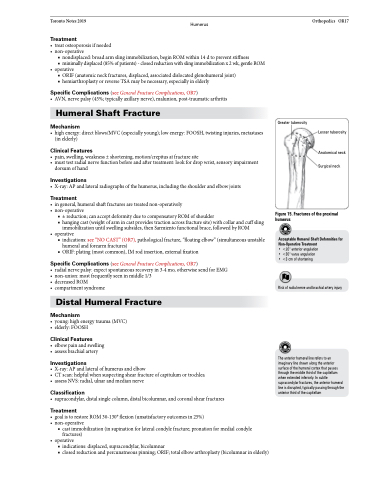Page 951 - TNFlipTest
P. 951
Toronto Notes 2019 Humerus
Treatment
• treatosteoporosisifneeded • non-operative
■ nondisplaced: broad arm sling immobilization, begin ROM within 14 d to prevent stiffness
■ minimallydisplaced(85%ofpatients)-closedreductionwithslingimmobilizationx2wk,gentleROM • operative
■ ORIF (anatomic neck fractures, displaced, associated dislocated glenohumeral joint) ■ hemiarthroplasty or reverse TSA may be necessary, especially in elderly
Specific Complications (see General Fracture Complications, OR7)
• AVN,nervepalsy(45%;typicallyaxillarynerve),malunion,post-traumaticarthritis
Humeral Shaft Fracture
Mechanism
• highenergy:directblows/MVC(especiallyyoung);lowenergy:FOOSH,twistinginjuries,metastases (in elderly)
Clinical Features
• pain,swelling,weakness±shortening,motion/crepitusatfracturesite
• musttestradialnervefunctionbeforeandaftertreatment:lookfordropwrist,sensoryimpairment
dorsum of hand
Investigations
• X-ray:APandlateralradiographsofthehumerus,includingtheshoulderandelbowjoints
Treatment
• ingeneral,humeralshaftfracturesaretreatednon-operatively • non-operative
■ ± reduction; can accept deformity due to compensatory ROM of shoulder
■ hanging cast (weight of arm in cast provides traction across fracture site) with collar and cuff sling
immobilization until swelling subsides, then Sarmiento functional brace, followed by ROM • operative
■ indications: see “NO CAST” (OR7), pathological fracture, “floating elbow” (simultaneous unstable humeral and forearm fractures)
■ ORIF: plating (most common), IM rod insertion, external fixation
Specific Complications (see General Fracture Complications, OR7)
• radialnervepalsy:expectspontaneousrecoveryin3-4mo,otherwisesendforEMG • non-union:mostfrequentlyseeninmiddle1/3
• decreasedROM
• compartmentsyndrome
Distal Humeral Fracture
Mechanism
• young:highenergytrauma(MVC) • elderly: FOOSH
Clinical Features
• elbowpainandswelling • assessbrachialartery
Investigations
• X-ray:APandlateralofhumerusandelbow
• CTscan:helpfulwhensuspectingshearfractureofcapitulumortrochlea • assessNVS:radial,ulnarandmediannerve
Classification
• supracondylar,distalsinglecolumn,distalbicolumnar,andcoronalshearfractures
Treatment
• goalistorestoreROM30-130°flexion(unsatisfactoryoutcomesin25%) • non-operative
■ cast immobilization (in supination for lateral condyle fracture; pronation for medial condyle fractures)
• operative
■ indications: displaced, supracondylar, bicolumnar
■ closedreductionandpercunatneouspinning;ORIF;totalelbowarthroplasty(bicolumnarinelderly)
Orthopedics OR17
Greater tuberosity
Lesser tuberosity
Anatomical neck Surgical neck
Figure 15. Fractures of the proximal humerus
Acceptable Humeral Shaft Deformities for Non-Operative Treatment
• <20° anterior angulation
• <30° varus angulation
• <3 cm of shortening
Riskofradialnerveandbrachialarteryinjury
The anterior humeral line refers to an imaginary line drawn along the anterior surface of the humeral cortex that passes through the middle third of the capitellum when extended inferiorly. In subtle supracondylar fractures, the anterior humeral line is disrupted, typically passing through the anterior third of the capitellum


